Introduction to AI and Machine Learning
In the rapidly evolving world of technology, Artificial Intelligence (AI) and Machine Learning (ML) are two terms that often come up in conversations. While they are closely related, they are not the same thing. This article aims to demystify these concepts and highlight the key differences between them.
What is Artificial Intelligence?
Artificial Intelligence is a broad field of computer science focused on creating systems capable of performing tasks that typically require human intelligence. These tasks include problem-solving, understanding natural language, recognizing patterns, and making decisions. AI can be categorized into two types: narrow AI, which is designed to perform a specific task, and general AI, which can perform any intellectual task that a human can.
What is Machine Learning?
Machine Learning, on the other hand, is a subset of AI that involves the development of algorithms that allow computers to learn from and make predictions or decisions based on data. Unlike traditional programming, where a programmer writes explicit instructions, ML algorithms improve their performance as they are exposed to more data over time.
Key Differences Between AI and Machine Learning
While AI is the broader concept of machines being able to carry out tasks in a way that we would consider "smart," ML is a specific approach to achieve AI. Here are some of the key differences:
- Scope: AI encompasses a wide range of technologies and applications, while ML is specifically focused on the development of algorithms that learn from data.
- Dependency on Data: ML algorithms require data to learn and improve, whereas AI systems can be rule-based and not necessarily learn from data.
- Applications: AI applications range from robotics to natural language processing, while ML is often used in data analysis, predictive modeling, and recommendation systems.
How AI and Machine Learning Work Together
Despite their differences, AI and ML often work hand in hand. ML provides the methods and techniques that enable AI systems to learn from experience. For example, an AI-powered chatbot uses ML to understand and respond to user queries more effectively over time.
Future Trends in AI and Machine Learning
The future of AI and ML is incredibly promising, with advancements in deep learning, neural networks, and quantum computing paving the way for more sophisticated applications. As these technologies continue to evolve, we can expect to see even more innovative solutions that leverage the power of AI and ML.
For those interested in diving deeper into these topics, exploring data science and tech trends can provide valuable insights into how AI and ML are shaping the future.
In conclusion, while AI and Machine Learning are interconnected, they serve different purposes within the realm of technology. Understanding these differences is crucial for anyone looking to navigate the complexities of modern tech innovations.
